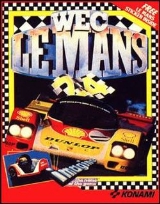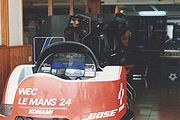
WEC Le Mans
Encyclopedia
WEC Le Mans, is a sim racing
arcade game
released in November 1986 by Konami
. It was the first video game to depict the 24 Hours of Le Mans
. The Lap of Le Mans is split up into 3 sections, as you pass through each of the 3 sections, the time of day changes from day to dusk, dusk to night, and night to dawn.
, and used force feedback to simulate road vibration in the form of a vibrating steering wheel
that reacts to the driver's acceleration and off-road bumps.
The game is known as being very difficult to complete, the tracks width remains constant at 3 lanes of racing, and any slight contact with an opposing race car will result in either a spin, or a spectacular flip in the air. Going off the course and running wide at a corner, will also end in a spin.

to Amstrad CPC
, Commodore 64
, MSX
, and ZX Spectrum
. A rumored port to the Amiga
and Atari ST
was mentioned, but never came to fruition.
The Spectrum version of the game earned critical acclaim and commercial success.
Today, the game can be played via MAME
.
Sim racing
Sim racing is the collective term for computer software that attempts to simulate accurately auto racing , complete with real-world variables such as fuel usage, damage, tire wear and grip, and suspension settings...
arcade game
Arcade game
An arcade game is a coin-operated entertainment machine, usually installed in public businesses such as restaurants, bars, and amusement arcades. Most arcade games are video games, pinball machines, electro-mechanical games, redemption games, and merchandisers...
released in November 1986 by Konami
Konami
is a Japanese leading developer and publisher of numerous popular and strong-selling toys, trading cards, anime, tokusatsu, slot machines, arcade cabinets and video games...
. It was the first video game to depict the 24 Hours of Le Mans
24 Hours of Le Mans
The 24 Hours of Le Mans is the world's oldest sports car race in endurance racing, held annually since near the town of Le Mans, France. Commonly known as the Grand Prix of Endurance and Efficiency, race teams have to balance speed against the cars' ability to run for 24 hours without sustaining...
. The Lap of Le Mans is split up into 3 sections, as you pass through each of the 3 sections, the time of day changes from day to dusk, dusk to night, and night to dawn.
Gameplay
The game attempted to realistically simulate car driving, with the car jumping up and down, turning back and forth, and spinning up to 180 degrees, with an emphasis on acceleration, breaking, and gear shifting, along with the need for counter-steering to avoid spin-outs. It also featured accurately simulated courses approved by the Automobile Club de l'OuestAutomobile Club de l'Ouest
The Automobile Club de l'Ouest , sometimes abbreviated to ACO, is the largest automotive group in France. It was founded in 1906 by car building and racing enthusiasts, and is most famous for being the organising entity behind the annual Le Mans 24 Hours race...
, and used force feedback to simulate road vibration in the form of a vibrating steering wheel
Racing wheel
A racing wheel is the preferred method of control for use in racing video games, racing simulators, and driving simulators. They are usually packaged with a large paddle styled as a steering wheel, along with a set of pedals for gas, brake, and sometimes clutch actuation, as well as various shifter...
that reacts to the driver's acceleration and off-road bumps.
The game is known as being very difficult to complete, the tracks width remains constant at 3 lanes of racing, and any slight contact with an opposing race car will result in either a spin, or a spectacular flip in the air. Going off the course and running wide at a corner, will also end in a spin.

Cabinet
Konami Released 3 different versions of the Video Arcade Game, an Up right machine, a 'mini' spin which the driver sat in a sit down cockpit and the 'Big' Spin version, the deluxe Arcade Version that would actually spin the gamer around a 360° spinning base, Turning left or right depending on the corner. The Front of the 'Big' Spin arcade machine looked like real Prototype C Race car.Home conversions
The game had several ports by Imagine SoftwareImagine Software
Imagine Software was a British video games developer based in Liverpool which existed briefly in the early 1980s, initially producing software for the ZX Spectrum and VIC-20...
to Amstrad CPC
Amstrad CPC
The Amstrad CPC is a series of 8-bit home computers produced by Amstrad between 1984 and 1990. It was designed to compete in the mid-1980s home computer market dominated by the Commodore 64 and the Sinclair ZX Spectrum, where it successfully established itself primarily in the United Kingdom,...
, Commodore 64
Commodore 64
The Commodore 64 is an 8-bit home computer introduced by Commodore International in January 1982.Volume production started in the spring of 1982, with machines being released on to the market in August at a price of US$595...
, MSX
MSX
MSX was the name of a standardized home computer architecture in the 1980s conceived by Kazuhiko Nishi, then Vice-president at Microsoft Japan and Director at ASCII Corporation...
, and ZX Spectrum
ZX Spectrum
The ZX Spectrum is an 8-bit personal home computer released in the United Kingdom in 1982 by Sinclair Research Ltd...
. A rumored port to the Amiga
Amiga
The Amiga is a family of personal computers that was sold by Commodore in the 1980s and 1990s. The first model was launched in 1985 as a high-end home computer and became popular for its graphical, audio and multi-tasking abilities...
and Atari ST
Atari ST
The Atari ST is a home/personal computer that was released by Atari Corporation in 1985 and commercially available from that summer into the early 1990s. The "ST" officially stands for "Sixteen/Thirty-two", which referred to the Motorola 68000's 16-bit external bus and 32-bit internals...
was mentioned, but never came to fruition.
The Spectrum version of the game earned critical acclaim and commercial success.
Today, the game can be played via MAME
MAME
MAME is an emulator application designed to recreate the hardware of arcade game systems in software on modern personal computers and other platforms. The intention is to preserve gaming history by preventing vintage games from being lost or forgotten...
.

